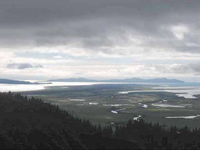Marine terraces cut into Pleistocene deposits on Wingham Island in the Gulf of Alaska provide new constraints on the position of sea level, ice thickness and total glacioisostatic rebound at the end of the Last Glacial Maximum. A radiocarbon age of 13.9 +- 0.15 ka on the most prominent terrace is coincident with the end of meltwater pulse 1A, possibly suggestive of a link between changes in relative sea level and terrace formation. Isostatic modeling suggests a local ice thickness of 600 to 700 m with high (~10 cm/yr) initial rates of postglacial rebound. In addition to the unique ties to meltwater pulse 1A, the timing of emergence for Wingham Island following the Last Glacial Maximum has implications for the early migration of humans into North America.


